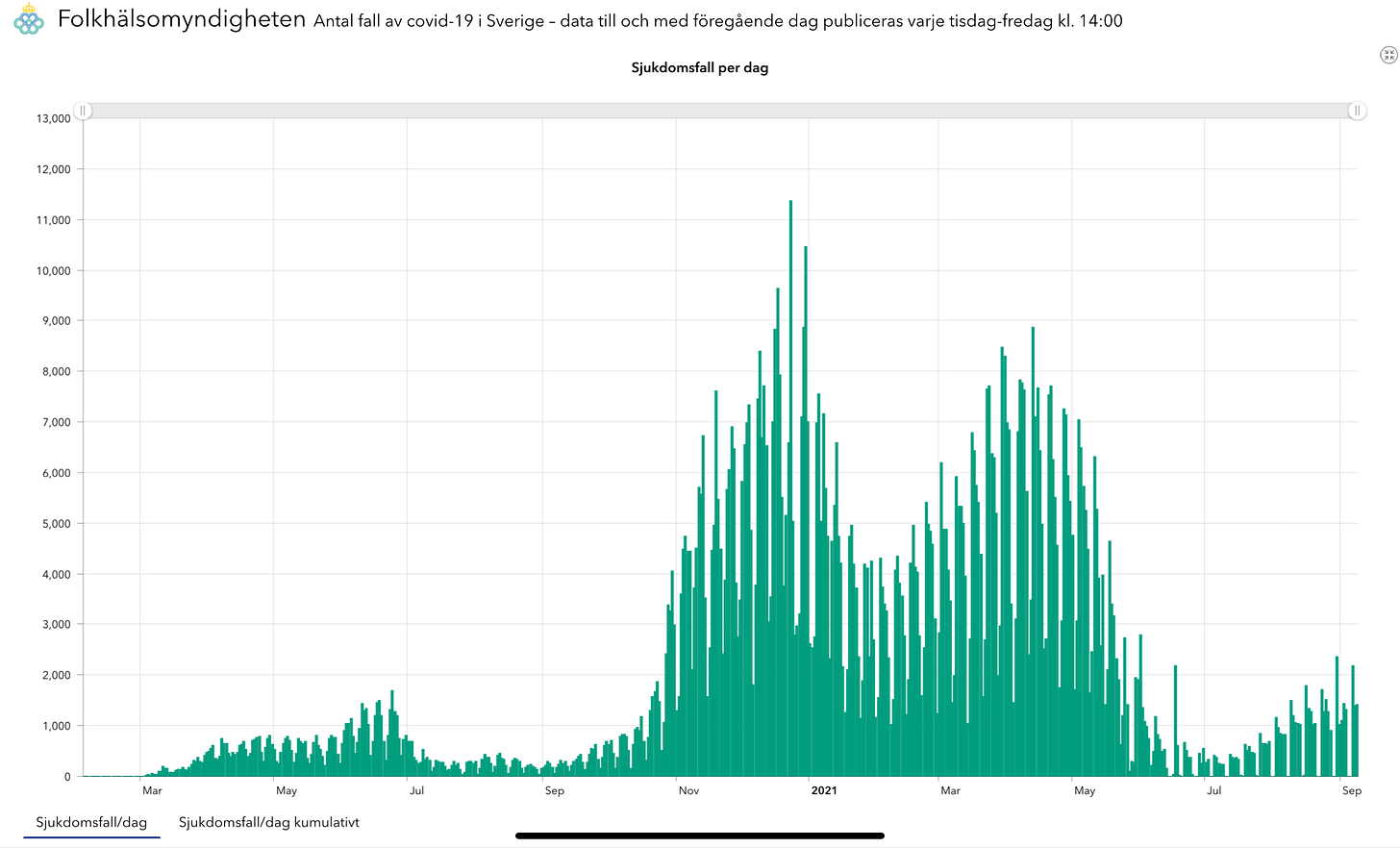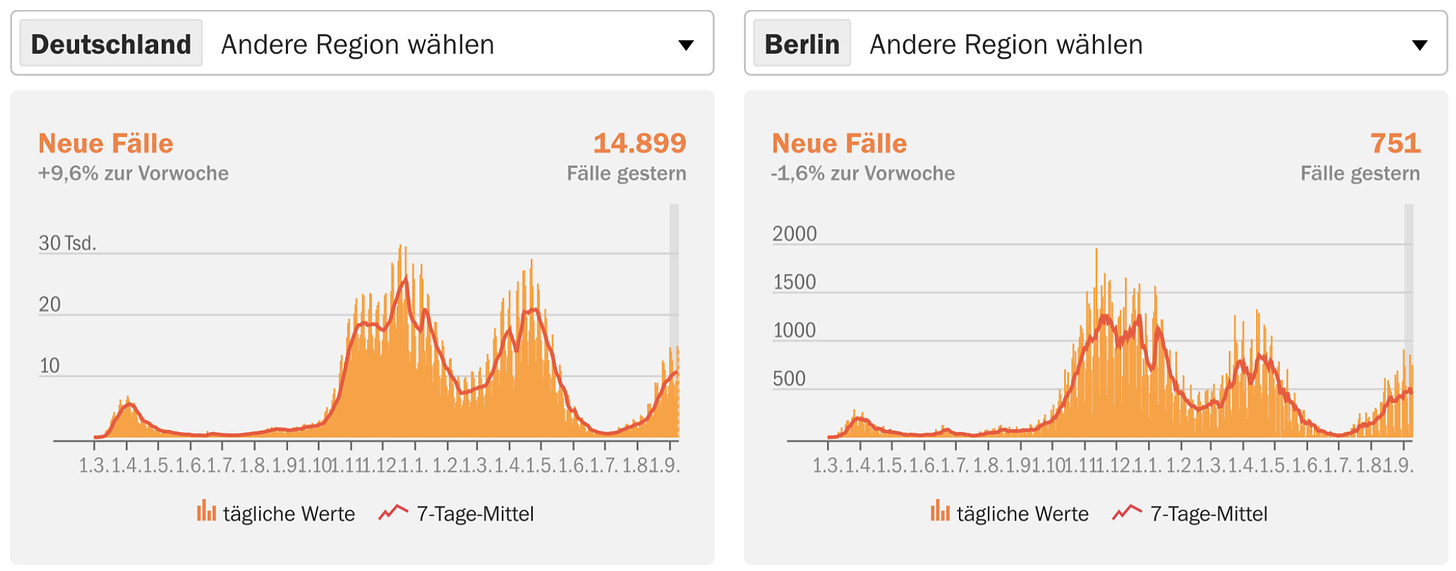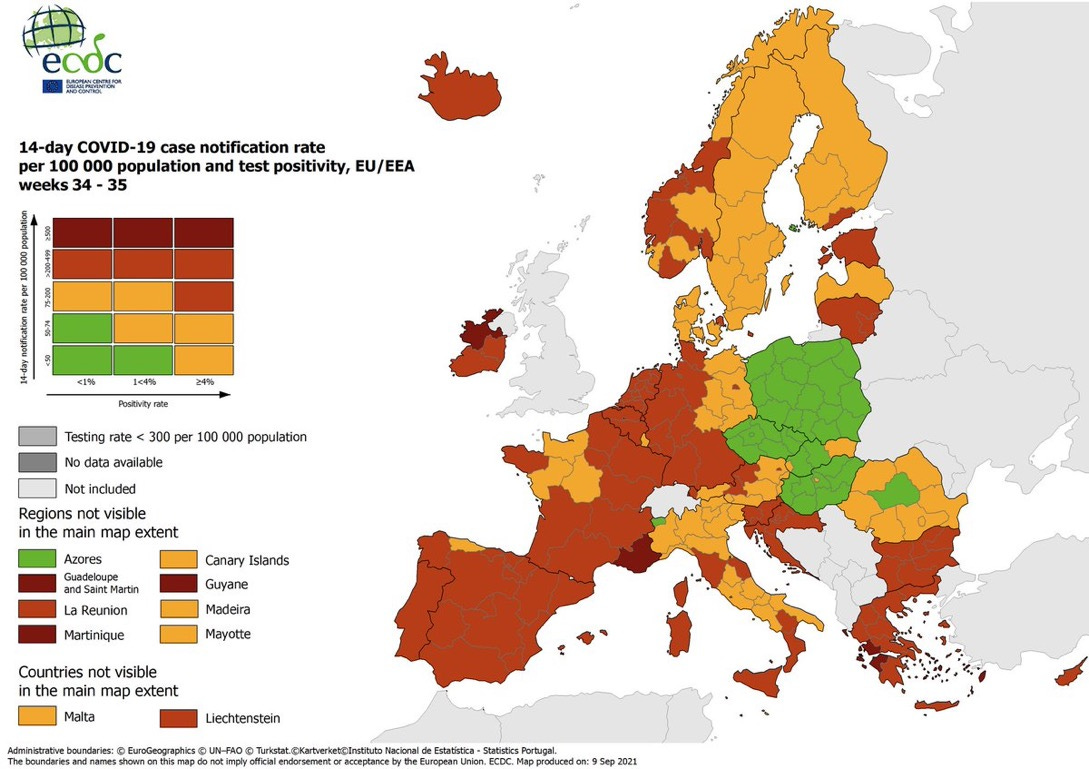🇩🇰
It is September 10, and today the Danish government will remove the designation that COVID is a “socially critical disease.” With the removal of the designation, there will no longer be any legal basis for justifying coronavirus restrictions. The last two remaining restrictions will thus become null and void.
They are:
The coronapas requirement for nightlife venues like discos and dance clubs is lifted.
Coronapas requirements for events with more than 2,000 spectators will be lifted.
-
The first booster doses were administered in Region Hovedstaden today. The region has deployed 15 vaccination outreach teams that will spend the next few weeks getting to each of Metro Copenhagen’s 200 or so nursing homes. They estimate there are about 13,000 seniors in the region who will need a third vaccine dose.
Deputy Director of the Emergency Preparedness Helene Bliddal Døssing:
"We rely on people with experiences in vaccination efforts, and it is some very experienced vaccinators who will provide the third dose so that it will be safe and secure. They have vaccinated citizens for many months in our permanent vaccination centers and this month also in the pop-up sites in the municipalities and at schools and universities. They are well prepared to also vaccinate residents in the care centers.”
Today the booster shot campaign began by inoculating about 170 residents at nursing homes in Herlev. The outreach teams will work Monday to Friday and will balance off the booster shot campaign with pop-up sites at schools to get people first and second doses as well.
The region says there will be mixing vaccines and seniors will get a third dose of the same vaccine they received in doses one and two.
-
Efforts to safeguard nursing home residents in Denmark are being stepped up as COVID infections have increased despite very high vaccination rates. About 96% of seniors in care in Denmark are fully vaccinated.
Minister of Social Affairs and the Elderly Astrid Krag says even fully vaccinated care home staff “will be encouraged” to take a weekly PCR test. Unvaccinated staff are recommended to take two tests each week. As well, all visitors to nursing homes across the country are asked to get tested, preferably a PCR test, beforehand.
Krag says all nursing home residents who have symptoms will also be tested.
“This autumn the key words are testing, cleaning, and vaccines, rather than isolation. Nursing home residents are one of the most vulnerable groups for COVID infection. Many have already paid a high price with months of isolation last year. We are not going to go into that again. With testing, cleaning, and revaccination, we must protect the residents, and at the same time maintain a good and safe everyday life with social activities and visits by friends, children, and grandchildren.”
Nursing homes have their own testing facilities for residents and staff.
Minister of Health Magnus Heunicke:
“We maintain testing opportunities at the country's nursing homes so that all employees can be tested at their workplace. In addition, today we are also in the process of revaccinating the nursing home residents, and as soon as the health authorities recommend it, we are also ready to offer the health staff a third dose.”
In addition to testing and booster shots, there will also be a focus on cleaning, ventilation, and hygiene practices in seniors homes to further mitigate against COVID spread.
Denmark is also launching a massive influenza vaccine campaign in October with seniors, and especially those in care, being among the high priority groups.
-
On the vaccination front so far, 4,427,139 1st doses (75.6% of the total population) have been administered while 4,276,594 people (73%) are fully vaccinated.
Yesterday, there were just 8,761 total inoculations done and of those 2,114 were 1st doses.
-
Denmark has reported 591 COVID infections and five more coronavirus deaths in the last day.
Yesterday, there were 97,814 total corona tests done, 51,399 PCR and 46,415 rapid, for a (PCR only) positivity percentage of 1.14%.
-
COVID hospitalizations (132) have increased (+4) while the number of infected people in an ICU (28) and of those the number on a ventilator (20) are both unchanged day to day.
While hospital admissions are increasing, they aren’t rocketing up like they did in previous waves, however, one expert is waving a warning flag.
Bispebjerg Hospital ICU Chief Physician Christian Wamberg spoke to DR:
“At present, the number of infection cases is not worrying, but if it continues to increase by more than two people every day over the coming weeks, then it may become worrying. I am more worried about those who have not yet been vaccinated.”
-
A new Danish study has concluded the Delta variant has a much higher risk of hospitalization among the unvaccinated. The Statens Serum Institut, Aalborg University, and the Danish Covid-19 Genome Consortium were the study authors. They examined hospitalizations in Denmark and concluded that someone who has the Delta variant and is unvaccinated is at 201% higher risk of being hospitalized than if they had the Alpha coronavirus strain.
That said, SSI's professional director Tyra Grove Krause adds that it is getting more difficult to assess the severity of new variants.
"This is because we are now experiencing fewer tests, other infection patterns, and a change in behavior, all the while the vaccines are being rolled out.”
So far, studies from England (132% higher risk), Scotland (82% higher), and Canada (108% higher) have all determined the Delta variant poses an increased risk of hospitalization. But a study out of Norway just this week found the exact opposite concluding the Delta variant poses no increased risk compared to the Alpha.
What we know, and has been universally concluded across the board, is that being vaccinated offers the best protection.
“The SSI has previously shown vaccination provides high protection against COVID hospitalization after infection with the Delta variant (94% for Pfizer and 97% for Moderna), and the new results again support the importance of being vaccinated.”
The study was published in The Lancet and you can find it HERE
-
On Sunday September 12 Region Nordjylland will close six more PCR testing sites as it continues to downsize its testing infrastructure as demand drops. The sites that will close are in Sæby, Hirtshals, Fjerritslev, Hurup, Frøslev, and Hadsund.
The region is also closing rapid COVID testing sites in Aalestrup and Arden. In both case, the last day of operations for both sites is Sunday.
The North Jutland health authority will deploy mobile testing sites, allowing it to respond to different areas as the testing need arises.
🇸🇪
Sweden has added 1,375 infections and two more corona deaths since yesterday’s update.
To date, 6,992,336 1st vaccine doses (81.9% of the population 16 years old and older) and 6,085,014 2nd doses (71.2%) have been administered.
-
As a number of COVID restrictions are set to be lifted on September 29, Sweden’s Chief Epidemiologist Anders Tegnell says they are prepared to reintroduce them if need be.
“I think you have to have a mental preparation because this is to some extent an unpredictable virus and there may be a development that makes us need to reintroduce restrictions.”
At the usual weekly COVID update press conference, Tegnell also insisted there was support from the healthcare sector for removing restrictions. This comes despite criticism from health experts who have voiced concerns in the media.
-
COVID cases are highest among school children as the number of infections continues to increase across Sweden, albeit at a slower rate. The Swedish Public Health Agency’s weekly report says coronavirus infections are most prevalent in the 10 to 17 year old age group.
Last week there 7,231 total coronavirus cases in Sweden, an increase of 8% from the week before. But the agency notes the number of weekly cases has been lower over the past three weeks than they were July, and for the first week of August.
Region Västmanland and Region Stockholm had the highest COVID incidence rate last week, followed by the Kronoberg and Norrbotten regions.
-
The Swedish Public Health Agency says since kids went back to school the number of respiratory infections have increased, but only a “small portion” of those have tested positive for COVID. The agency is providing no specific numbers in sharing this information, only saying, for example, that “many” children have symptoms of respiratory infections, coughing, runny nose, etc.
While it says only a small number of children have tested positive for the coronavirus, it adds “it is mainly other types of respiratory infections” that are spreading among children. It does not specify what other types. We know that nearby Denmark is seeing astounding numbers of RS virus infections much earlier than its ever been seen before.
Department Head Britta Björkholm says they have increased testing to screen for infections, especially for children between 10 and 20 years old.
Björkholm adds that is is u fortunate that in some cases entire classes have been sent home to isolate.
“Despite the fact that a lot of children and young people have to be at home, the vast majority of classes are doing in-person learning. This is good because being at school is the best thing for most young people.”
The health agency says there are a number of preventive measures in schools to try and reduce infection spread. Children have stepped up their hygiene routines for example. The Swedish Public Health Agency recommends that people who have symptoms stay home and everyone, especially teachers and school staff, should make sure they are fully vaccinated.
🇳🇴
Norway has added 1,611 infections and one more virus death in the last day.
COVID hospitalizations (104) have jumped (+7) while the number of infected people in an ICU (38) inched up (+1) of those the number on a ventilator (18) also increased (+4).
So far, 73.15% of Norwegians have had one vaccine dose and 62.89% have had both.
-
Norway has deployed COVID self-testing kits to be used mainly for students to provide a level of screening for the virus that should reduce infections and school disruptions. But the Norwegian Institute for Public Health is warning that while there are benefits, there are also some serious drawbacks.
NIPH Director Camilla Stoltenberg says having children test themselves at home provides some assurances.
“The fact that we get to test more in this period is positive because self-testing is a substitute for more intrusive measures such as quarantine for young people and young adults. They can thus go to school and study when they are not infected themselves, rather than being quarantined at home.”
However, she says, because the tests results are checked at home and not at a laboratory, there is a higher risk of false positives and false negatives. Stoltenberg says any positive self-test needs to be confirmed with a PCR test. She says the other problem is the sheer abundance of self-testing will erode the agencies ability to see what is happening on the ground. This will impact the ability to do accurate modeling.
“When the data we enter into the models is weakened, the analyzes we get out of them are of course also weakened. In particular, uncertainty in the models increases during the transition period, when the test regime changes. We are now looking at how we can adapt the models to this new situation.”
Self-testing kits work a lot like pregnancy testing kits do. People use swabs up the nose or in the back of the throat, mix the swab in a solution, then put a few drops on the testing stick to produce either a negative or positive result, which happens within a few minutes.
🇫🇮
Finland has registered 486 infections since yesterday’s update.
To date, 4,064,019 1st doses (72.6% of the population) have been administered while 3,039,996 people (54.5%) have been fully vaccinated.
-
Finland’s 4th infection wave appears to be easing. The latest weekly assessment by the Finnish Institute for Health said there were 3,842 COVID cases last week, about 300 fewer than the week before. And the hospital situation remains fairly stable.
The agency says 5% of coronavirus cases last week were travel related, but only 0.3% of those resulted in further infection spread thanks to border screening.
Last week in Finland there were 11,849 people in quarantine, a number that hasn’t changed much from the week prior.
As seen in other countries, the health institute says most of the COVID patients in hospitals across the country are unvaccinated. It emphasizes the risks are much higher for those who are unvaccinated than they are for people with one or both doses. The agency says in the last two weeks unvaccinated people between the ages of 10 to 49 years old made up the largest share of all COVID infections. Even infections among people with just one dose there was less than half the rates seen among the unvaccinated.
🇩🇪
“Too many are still unvaccinated to overcome the pandemic” Germany’s Health Minister Jens Spahn continues to warn about a vaccination campaign that is now “making slow progress.”
To date, 51.3 million people in Germany (61.7%) are fully vaccinated, while 55 million (66.2%) have at least one dose. For the adult population Spahn says 72.4% are vaccinated, but it is still not enough.
For a second straight day, Germany has reported daily COVID infections numbers exceeding 14,000, numbers not seen since May.
🇮🇹
Italy is close to launching a booster shot campaign. The Italian Medicines Agency has approved the administration of a third vaccine dose to vulnerable populations and some healthcare workers.
Specifically, the booster shot priority would be for all seniors 80 years old and older, people who are immunocompromised, and nursing home residents.
Italian health authorities say a third dose can be given six months after the second shot, with the exception of immunocompromised people who only need to wait four weeks.
A final decision now rests with Italy’s Ministry of Health.
🇪🇺
This is the latest assessment of COVID risk across the European Union put out by the European Centre for Disease Prevention today.
Worth noting while high-risk red continues to spread across EU nations, Denmark over the last two weeks has gone from mostly red to almost entirely orange now.
🇪🇺✈️
The European Union’s Council of Ministers has taken Japan, Albania, Armenia, Azerbaijan, Brunei, and Serbia off the list of ‘secure destinations.’ In each case, the coronavirus situation was the key factor in making the decision.
The EU has added Uruguay to its ‘safe countries’ list, which now has a total of 12 nations outside of Europe on it.
The list is used to coordinate entry rules for travelers coming into the EU. The 27 member states are not bound by the list, but can make their own decisions about levying restrictions on travelers from certain countries.
🇨🇦
Canada reported 3,654 infections and another 39 coronavirus deaths yesterday pushing the pandemic total loss of life to 27,106.
Over the last seven days Canada has had a positivity percentage of 5%.
On the vaccination front to date, 28,225,982 1st doses (74.14% of the total population) have been administered while 25,823,245 people (67.83%) are fully vaccinated.
In Ontario today there were 728 new COVID cases and of those 620 were either not vaccinated or had just a single dose. There are 365 people in hospital, with 331 of them being unvaccinated or not yet fully vaccinated. Of the 185 people in an ICU, that number is 174.
Quebec reported 703 new infections and another corona death. Hospitalizations in the province have tripled in the last month, while ICU numbers have quintupled.
In Atlantic Canada, Nova Scotia has 17 new infections. New Brunswick has 17. Newfoundland and Labrador has yet to report.
Manitoba saw 54 new corona cases and one more death today.
There were in 278 infections in Saskatchewan today.
Alberta registered 1,166 new infections and another 18 deaths. There are 500 people in a hospital with 76.6% of them unvaccinated or having just one dose. Of the additional 147 in an ICU, that number is 89%.
B.C. logged 814 infections and no new deaths. 92% of all COVID patients in an ICU in the province as of yesterday were not fully vaccinated.














